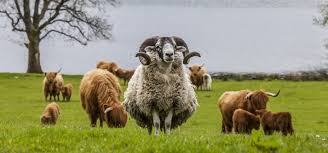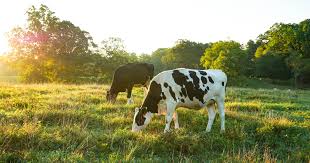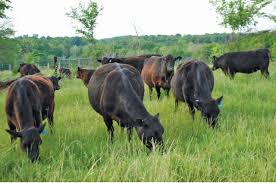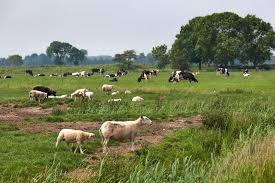Animal grazing is a fundamental aspect of livestock management that significantly impacts animal health, pasture quality, and environmental sustainability.
Proper grazing techniques not only enhance the productivity of livestock but also contribute to the preservation of natural resources.
As agricultural practices evolve, it is essential to adopt strategies that ensure the health of grazing animals while maintaining the ecological balance of the land.
Grazing refers to the practice of allowing animals to feed on pasture plants. It is a natural behavior for many species, including cattle, sheep, and goats, which have evolved to thrive on grass and other forage.
However, the way in which grazing is managed can have profound effects on both the animals and the land. Overgrazing, for instance, can lead to soil degradation, loss of plant diversity, and diminished pasture productivity.
Conversely, well-managed grazing can promote healthy pasture growth, improve soil quality, and enhance biodiversity.
One of the key principles of proper grazing management is the concept of rotational grazing. This method involves dividing pastures into smaller sections and rotating livestock through these areas.
By allowing certain sections to rest and recover while animals graze on others, this technique promotes healthier pasture growth and reduces the risk of overgrazing.
Rotational grazing helps maintain plant vigor, encourages root development, and allows for the regeneration of forage, ultimately leading to better animal nutrition and increased forage yield.
Another important aspect of grazing management is understanding the carrying capacity of the land. Carrying capacity refers to the maximum number of animals that a specific area can support without causing damage to the vegetation or soil. It is essential for farmers and ranchers to assess their pastures regularly to determine the optimal stocking rates.
By maintaining a balance between the number of grazing animals and the available forage, producers can ensure the long-term sustainability of their grazing systems.
In addition to these techniques, proper animal grazing involves considering the seasonal needs of both the livestock and the pasture. Different plants have varying growth patterns and nutritional values throughout the year. Understanding these dynamics allows farmers to plan grazing schedules that maximize forage quality and availability.
For example, grazing during the growing season can take advantage of lush, nutrient-rich grasses, while allowing pastures to rest during dormancy periods can help maintain soil health and reduce erosion.
Furthermore, integrating conservation practices into grazing systems can enhance the sustainability of livestock operations. Techniques such as soil conservation, water management, and habitat preservation are vital for maintaining the health of grazing lands.
Utilizing cover crops, maintaining buffer strips, and implementing erosion control measures can improve soil structure, enhance water retention, and support wildlife habitats.
Proper animal grazing and preservation techniques are essential for sustainable livestock management. By implementing practices such as rotational grazing, understanding carrying capacity, considering seasonal needs, and integrating conservation strategies, farmers can create a balance between animal health and environmental stewardship.
These techniques not only improve the productivity of livestock but also contribute to the long-term health of our ecosystems, ensuring that grazing lands remain viable for future generations.
Types of Grazing Systems

There are several types of grazing systems that farmers use, depending on the available land, livestock, and environmental conditions. The key grazing systems include:
1. Continuous Grazing: In continuous grazing, animals are allowed to graze on the same piece of land throughout the grazing season. While it’s simple and requires less management, it can lead to overgrazing if not carefully monitored.
2. Rotational Grazing: In this system, animals are moved between different paddocks or sections of the grazing land. This allows the grass in one area to recover while the animals graze in another, preventing overgrazing and promoting healthy plant regrowth.
3. Strip Grazing: Strip grazing involves confining animals to a small strip of pasture, often with the use of temporary fencing. Once the animals graze down the strip, they are moved to the next section. This system helps to control the amount of grazing and prevents pasture wastage.
4. Mob Grazing: In mob grazing, animals are grouped into large herds and graze a small area for a very short period. This high-intensity, short-duration grazing mimics natural grazing patterns and promotes healthy plant growth.
5. Deferred Grazing: Deferred grazing involves allowing some sections of the pasture to rest and recover while others are grazed. The rested pasture is used at a later time, usually when the grazing land has regrown sufficiently.
Best Practices for Effective Grazing
To ensure grazing is effective and sustainable, certain best practices need to be followed:
1. Monitor Pasture Conditions: Regularly check the condition of the pasture to ensure it is not being overgrazed. Look for signs of overgrazing such as bare soil, reduced plant diversity, and poor plant growth.
2. Implement Rotational Grazing: Rotational grazing is one of the most effective ways to manage grazing. By moving animals between paddocks, the pasture gets time to recover, preventing overgrazing and soil degradation.
3. Provide Adequate Water Sources: Animals should always have access to clean and sufficient water. Ensure water points are evenly distributed across the grazing land to encourage animals to graze in different areas.
4. Use Fencing Wisely: Proper fencing is essential for managing grazing systems like strip grazing or rotational grazing. Temporary fences can be used to control animal movement, while permanent fences should be used for dividing larger paddocks.
5. Supplement Feed When Necessary: During periods of drought or low grass availability, provide supplemental feed to ensure that animals are getting enough nutrition without overgrazing the pasture.
Read Also: 15 Medicinal Health Benefits Of Calea ternifolia (Dream Herb)
Preservation Techniques for Grazing Lands

To maintain the long-term productivity of grazing lands, farmers need to adopt preservation techniques that protect the soil and plants:
1. Prevent Soil Erosion: Use cover crops or plant trees around the grazing areas to prevent wind and water erosion. This helps to keep the soil intact and fertile.
2. Promote Plant Diversity: Encouraging the growth of a variety of grasses and legumes increases the nutritional value of the pasture and prevents the domination of unwanted species.
3. Reseed Grazing Land: In areas where the grass is thinning out, reseeding with native grass species helps restore the pasture’s productivity.
4. Control Weeds and Invasive Species: Weeds and invasive plants can take over grazing lands if left unchecked. Regularly inspect the pasture and remove any unwanted species.
5. Manage Animal Stocking Rates: Overstocking the land with too many animals leads to overgrazing. Adjust the number of animals based on the carrying capacity of the land.
Rotational Grazing and Its Benefits
Rotational grazing is one of the most effective grazing management systems, offering several benefits to both the land and the animals:
1. Enhanced Pasture Growth: By allowing sections of the pasture to rest, rotational grazing promotes healthier plant growth. This leads to more nutritious and abundant grass for animals to feed on.
2. Improved Soil Health: Rotational grazing reduces soil compaction and erosion. The rest period allows the soil to recover, resulting in better water infiltration and nutrient cycling.
3. Better Livestock Performance: Animals in rotational grazing systems have access to fresh, high-quality forage, leading to better weight gain, higher milk production, and improved overall health.
4. Weed and Pest Control: The frequent movement of animals disrupts the life cycles of weeds and pests, reducing the need for chemical controls. This leads to a more natural and healthy grazing environment.
5. Reduced Environmental Impact: Rotational grazing is a sustainable system that minimizes soil erosion, improves water retention, and reduces the need for external inputs like fertilizers and pesticides.
Read Also: Powdery Scab (Potatoes): Description, Damages Caused, Control and Preventive Measures
Managing Overgrazing and Its Effects

Overgrazing occurs when animals feed on grasslands without giving plants enough time to recover. This results in reduced plant cover, soil erosion, and poor land productivity. Managing overgrazing is crucial to maintaining a healthy grazing system. Here are ways to address and prevent overgrazing:
1. Implement Rotational Grazing: One of the most effective strategies to manage overgrazing is rotating animals between different paddocks. This ensures that no single area is grazed continuously, giving the grass time to recover.
2. Set Appropriate Stocking Rates: Ensure the number of grazing animals matches the land’s capacity. Overstocking the pasture leads to overgrazing and the depletion of available forage.
3. Monitor Grazing Patterns: Regularly check the condition of the grazing land. If grass is growing slower, reduce grazing pressure or move animals to another paddock.
4. Use Rest Periods: Allow specific sections of the grazing area to rest and recover, especially after heavy grazing. This helps prevent permanent damage to plant roots and allows natural regrowth.
5. Supplement Animal Feed: During dry seasons or times when grass is insufficient, provide supplemental feed to reduce pressure on the land.
Soil and Water Conservation in Grazing Areas
Soil and water conservation is essential in grazing areas to prevent degradation and maintain a productive environment for both plants and animals. Here are key techniques to ensure proper conservation:
1. Use Contour Farming: By grazing animals along the contour lines of slopes, water runoff is slowed down, reducing soil erosion and retaining more moisture in the ground.
2. Establish Buffer Zones: Plant vegetation like trees or shrubs around water sources and along slopes to prevent soil erosion and water contamination. This keeps soil in place and promotes better water infiltration.
3. Build Watering Points Away from Grazing Areas: Concentrating watering points can lead to soil compaction and erosion. Spread out watering points to reduce animal traffic in one area, and use portable water tanks when possible.
4. Improve Water Retention: Incorporating organic matter into the soil and planting cover crops helps retain moisture, reducing the need for irrigation and minimizing water loss.
5. Reduce Soil Compaction: Overgrazing and heavy animal traffic lead to soil compaction, which reduces the soil’s ability to absorb water. Use lighter animals, manage grazing intensity, and give the soil time to recover.
Sustainable Grassland Management Practices
Sustainable grassland management ensures that grazing areas remain productive for both animals and the environment over time. Here are some key practices:
1. Encourage Biodiversity: Planting a variety of grasses and legumes improves the nutrient balance in the soil and supports healthy livestock growth. Diverse plant species also make the grassland more resilient to pests, diseases, and droughts.
2. Use Native Plants: Native grass species are well-adapted to local climates and soil types. They require less water and maintenance while providing high-quality forage for animals.
3. Avoid Overstocking: Sustainable grassland management includes maintaining an appropriate number of animals on the pasture. Overstocking reduces grass cover, leading to overgrazing and erosion.
4. Practice Integrated Pest Management (IPM): Managing pests in grasslands through IPM techniques reduces the reliance on chemical pesticides. This includes monitoring pest populations, promoting natural predators, and using resistant plant varieties.
5. Reseeding and Pasture Renovation: Reseeding areas where grass cover is thinning or has been damaged ensures that the grassland remains productive. Use drought-resistant and fast-growing grass varieties for best results.
Techniques for Restoring Degraded Grazing Lands
Degraded grazing lands often suffer from poor soil quality, reduced vegetation, and loss of productivity. Restoring these lands is possible through several effective techniques:
1. Reseeding with Perennial Grasses: Introducing perennial grass species to degraded areas improves soil structure and provides long-term ground cover. These grasses offer better resistance to drought and grazing pressure.
2. Use Cover Crops: Planting cover crops during the off-season helps protect the soil from erosion and restores its fertility. Cover crops like clover and alfalfa fix nitrogen in the soil, improving its overall health.
3. Controlled Grazing: Limiting animal access to degraded areas allows the land to rest and recover. Rotate animals to other sections or temporarily exclude them from sensitive areas to promote vegetation regrowth.
4. Soil Amendment: Adding organic matter like compost, manure, or mulch to degraded soil improves its structure, increases water retention, and restores fertility. This encourages healthier plant growth.
5. Implement Erosion Control Structures: In areas prone to erosion, build terraces, check dams, or swales to slow down water runoff. These structures help prevent further soil loss and allow vegetation to reestablish.
Do you have any questions, suggestions, or contributions? If so, please feel free to use the comment box below to share your thoughts. We also encourage you to kindly share this information with others who might benefit from it. Since we can’t reach everyone at once, we truly appreciate your help in spreading the word. Thank you so much for your support and for sharing!
Read Also: How to Graft an Avocado Tree to Produce Avocado Fruit

